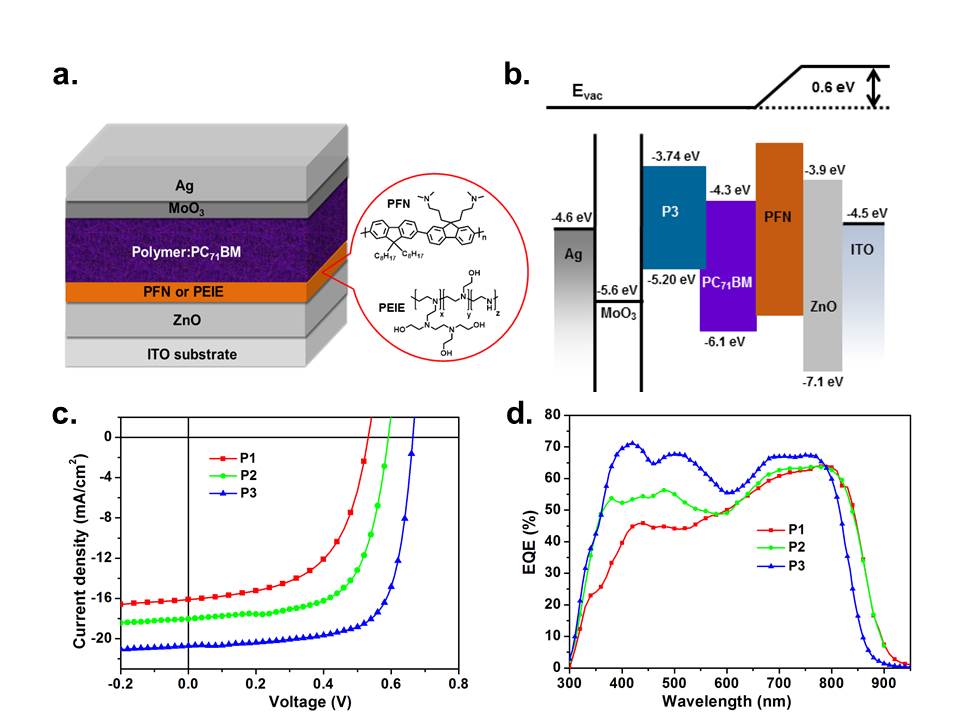Organic semiconducting materials have received a great deal of attention from academia and industry due to the solution-based processing techniques. Recently a group led by Xugang Guo, an associate professor in the Department of Materials Science and Engineering (MSE) at SUSTech, made progress in the field of organic field-effect transistors and organic solar cells. His group developed a series of high-performance organic semiconducting materials. In combination with device engineering, the group achieved state-of-the-art power conversion efficiencies (PCEs) in organic solar cells field. The corresponding results are published in the Journal of American Chemical Society (JACS), Chemistry of Materials, and Advanced Materials. The semiconducting materials are filed for PCT patents.
The solution-based processability enables the fabrication of large area electronic devices in a cost effective fashion and affords the deviecs with new features and functionalities, such as light-weight and mechanical flexibility. In the paper, entitled “Marked Consequences of Systematic Oligothiophene Catenation in Thieno [3,4-c] pyrrole-4,6-dione and Bithiopheneimide Photovoltaic Copolymers”, Xugang Guo developed a series of oligomeric thiophene-based copolymer semiconductors and thoroughly investigated the effects of thiophene number and solubilized chain patterning on the semiconductor energy level, thin film morphology, and solar cell performance. The results showed that with the increase of thiophene number, the semiconductor film crystallinity will be increased gradually accompanied by the elevated frontier orbital energy levels, which lead to reduced open circuit voltages of the solar cells. It was found that the terthiophene-based polymer semiconductors achieved the optimal combination of the energy level and film morphology, hence resulting in the highest power conversion efficiency. The results offer insights to the design of polymer semiconductors based on oligothiophenes with the optimal thiophene linkage and alkylation pattern. The work was published in JACS ( Impact factor: 13.038 ), where Xugang Guo is the corresponding author, responsible for materials design and synthesis. Materials characterization and device preparation were performed by Prof. Lin X. Chen’s Group at the Argonne National Laboratory and Prof. Tobin J. Marks Group at Northwestern University, USA.

Figure 1. Effect of oligothiophene catenation on the performance of polymer solar cells.
In the paper entitled “Materials Design via Optimized Intramolecular Noncovalent Interactions for High-Performance Organic Semiconductors”, Xugang Guo Group has developed a building block based on bithiophene unit, which can form intramolecular noncovalent sulfur-oxygen interaction by introducing oxygen atom, hence the polymer semiconductor shows high degree planarity, increased film crystallinity with a narrow bandgap. The bithiophene and phthalimide polymer semiconductors achieve remarkable device performance in organic field-effect transistors and polymer solar cells. This work was highly rated by the editor of Chemistry of Materials ( Impact factor: 9.407; CM ), which was accepted directly. The editor appreciates the excellent work contributed by the team. The paper was among the most read in April and May published in Chemistry of Materials. Xiaojie Guo and Qiaoqian Liao from Xugang Guo Group are co-first authors of the paper, completing the material synthesis and solar cell fabrication and characterization, respectively. Tobin J. Marks Group at Northwestern University use synchrotron radiation to complete the materials characterization. Professor Kang-Jun Baeg at the Pukyong National University in Republic of Korea fabricated and characterized organic thin-film transistors. Internal Collaborators include Dr. Tingbin Yang, associate professor Yongye Liang and professor Xin Cheng in MSE department.

Figure 2. Intramolecular noncovalent Sulfur-Oxygen interaction can lead to increased polymer backbone poplanarity and film crystallinity.
The recent paper entitled “Head-to-Head Linkage Containing Bithiophene-Based Polymeric Semiconductors for Highly Efficient Polymer Solar Cells” reports a series of narrow bandgap polymer semiconducting materials incorporating bithiophene donor monomer and benzothiadiazole receptor comonomer. These polymers have achieved greater than 0.8 cm2 V-1s-1 carrier mobility in organic field-effect transistor and nearly 10% energy conversion efficiency in solar cells, which is the highest efficiency reported to date in the bandgap smaller than 1.50 eV for polymer semiconductors. The materials show substantial absorption in visible region. The short-circuit current of the fabricated solar cell reaches 22.40 mA cm-2, which is the highest short-circuit current in the field of organic solar cells. This paper was published in Advanced Materials (Impact factor :18.960 ). Shengbin Shi and Qiaoqiang Liao from Xugang Guo Group are co-first authors, completing the materials synthesis and solar cell fabrication and characterization, respectively. Han Guo, a research associate from the same group, performed the transistor fabrication and characterization. Professor Feng Liu from Shanghai Jiaotong University and the Lawrence Berkeley National Laboratorycarried out materials characterization using synchrotron radiation. Internal Collaborators include Dr. Tingbin Yang, associate professor Yongye Liang and professor Xin Cheng in MSE department.

Figure 3. Solar cell structure, energy level and voltage-current curve.
Since joining SUSTech, Xugang Guo Group have published more than 10 papers in high-profile journals including Chemical Reviews, Nature Photonics, Advanced Materials, JACS, and PNAS. The projects in Guo’s grop are funded by Shenzhen Peacock Team, Shenzhen Key Laboratory, National Natural Science Foundation of China, Guangdong Provincial Natural Science Foundation, Shenzhen Municipal Science and Technology Innovation Committee Foundation Research Fund, and the Vice President for Research Fund.
Paper Links:
http://pubs.acs.org/doi/abs/10.1021/jacs.5b06462
http://pubs.acs.org/doi/abs/10.1021/acs.chemmater.6b00850
http://onlinelibrary.wiley.com/doi/10.1002/adma.201603112/full
Proofread By
Photo By